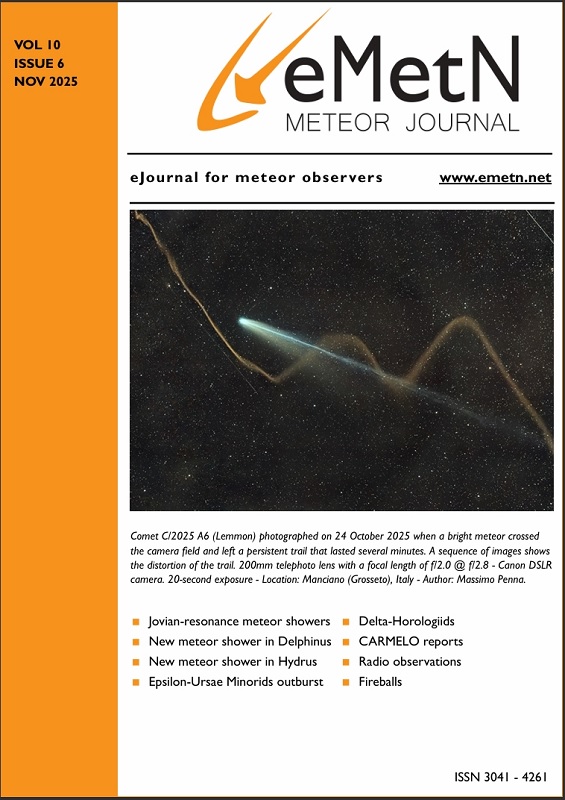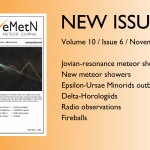Mariasole Maglione (GAV, Gruppo Astrofili Vicentini)
Lorenzo Barbieri (CARMELO network and AAB, Associazione Astrofili Bolognesi)
Silvana Sarto (CARMELO network and AAB, Associazione Astrofili Bolognesi)
Introduction
In May, the CARMELO network did not detect particularly intense meteoric activity. Early in the month there was a peak, though not very pronounced, of the Eta Aquariids (ETA) shower on the night of May 5-6. We also report the detection of a meteoric outburst probably related to comet 73P/Schwassmann-Wachmann in early June.
Methods
The CARMELO network consists of SDR radio receivers. In them, a microprocessor (Raspberry) performs three functions simultaneously:
- By driving a dongle, it tunes the frequency on which the transmitter transmits and tunes like a radio, samples the radio signal and through the FFT (Fast Fourier Transform) measures frequency and received power.
- By analyzing the received data for each packet, it detects meteoric echoes and discards false positives and interference.
- It compiles a file containing the event log and sends it to a server.
The data are all generated by the same standard, and are therefore homogeneous and comparable. A single receiver can be assembled with a few devices whose total current cost is about 210 euros.
To participate in the network read the instructions on this page.
May data
In the plots that follow, all available at this page, the abscissae represent time, which is expressed in UT (Universal Time) or in solar longitude (Solar Long), and the ordinates represent the hourly rate, calculated as the total number of events recorded by the network in an hour divided by the number of operating receivers.
In fig.1, the trend of signals detected by the receivers for the month of May.
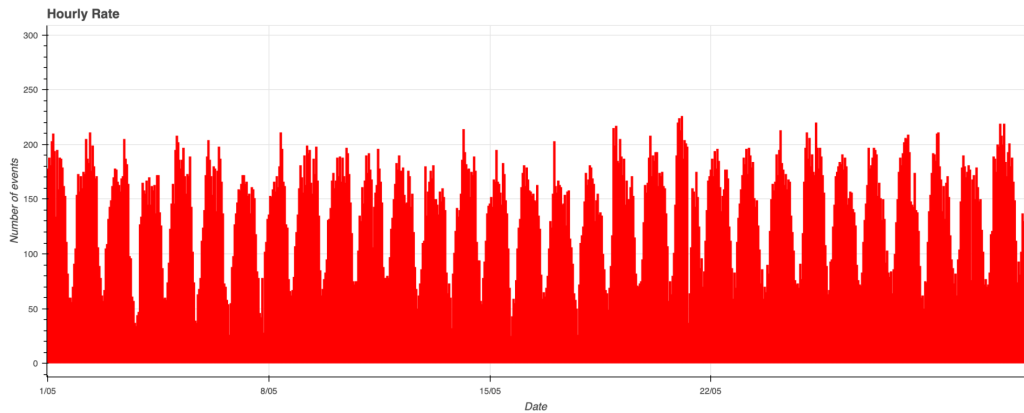
Fig. 1: May 2025 data trend.
Eta Aquariids
Eta Aquariids (ETAs) are a meteoric shower active every year between mid-April and late May, with a peak visibility around May 6. Although less conspicuous than better-known showers, the Eta Aquariids are of some special importance because of their origin: their fragments come from the famous Halley’s comet, the same comet that also gives rise to the Orionids in October (1).
The radiant of the shower is located in the constellation Aquarius, near the star Eta Aquarii, from which it takes its name. In our latitudes this point rises just before sunrise, around 3:30 a.m., making the last hours of the night the most suitable time for observation and detection. Because of the radiant’s low position on the horizon, the number of meteors visible in Italy is generally limited to about 30 to 40 per hour. In the southern regions, where the radiant rises much higher on the horizon, the shower instead offers a far more intense show, with hourly rates at zenith (ZHR) that can exceed 50-60 meteors per hour.
Eta Aquariids are also distinguished by the high speed of the meteors, which can reach over 66 km/s. This makes their tracks in the sky particularly bright and persistent, with trails that sometimes persist for several seconds.
In 2025, the peak in the shower’s activity was expected on the night of May 5-6. The CARMELO network recorded moderate activity, particularly between 2:00 a.m. and 5:00 a.m. on May 6, where the maximum count was 204 events at 2:00 a.m. when the radiant was still below the horizon, and thereafter, around dawn, it hovered between 170 and 180 events, between solar longitudes 45.55° and 45.67°.
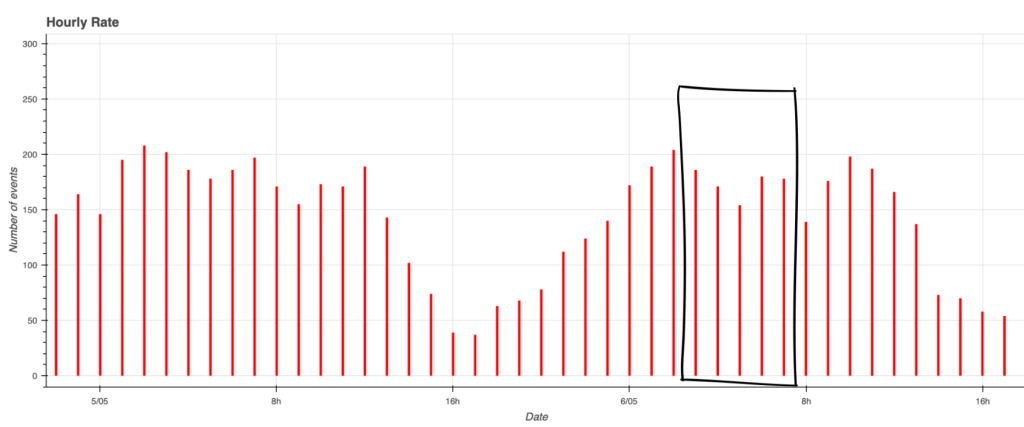
Fig. 2: Hourly rate between May 5 and 6, 2025, with very moderate meteoric activity.
The outbursts of May 31 and June 1
On June 6, the Central Bureau for Astronomical Telegrams published CBET 5561 (2), reporting two intense meteor outbursts potentially associated with the minor swarm of Tau Herculids (61 TAH), generated by fragments of comet 73P/Schwassmann-Wachmann. The observations were conducted by the Croatian Meteor Network, which showed two distinct peaks in the hourly rate of meteors, the second of which ended abruptly around 0:00 UTC on June 2 (solar longitude 70.71°).
When a comet such as 73P/Schwassmann-Wachmann fragments (as it did spectacularly in 1995, with further ruptures observed in 2006), it releases material in large quantities: large and small fragments, dust, and meteoroids that are ejected with slightly different velocities from each other. These differences in initial velocities, even small ones, lead over time to meteoroids being distributed along the comet’s orbit unevenly. This process is called differential expansion: faster particles move forward, slower particles stay behind. After years or decades, these “clouds” separate, generating packets or filaments that can intersect Earth’s orbit at specific times, resulting in brief but intense meteor outbursts.
In the case of comet 73P, several modeling studies (3) predicted that debris ejected in the 1995 and 2006 passages-key years for its breakup events-might have reached Earth around 2022-2025. The behavior observed these days is consistent with the arrival of one of these meteoroid filaments, confirming the simulations.
Looking at the data from the CARMELO network, we indeed notice an increase in the number of meteor echoes detected between June 1 and June 2, followed by a sudden decrease right at solar longitude 70.71° as indicated in CBET.
The shower’s radiant associated with comet 73P was transiting the meridian right around midnight. This means that no significant change in the observing geometry had occurred at the time of the dip. The abrupt drop in meteor activity could therefore be blamed on the cessation of the meteoroid flux.
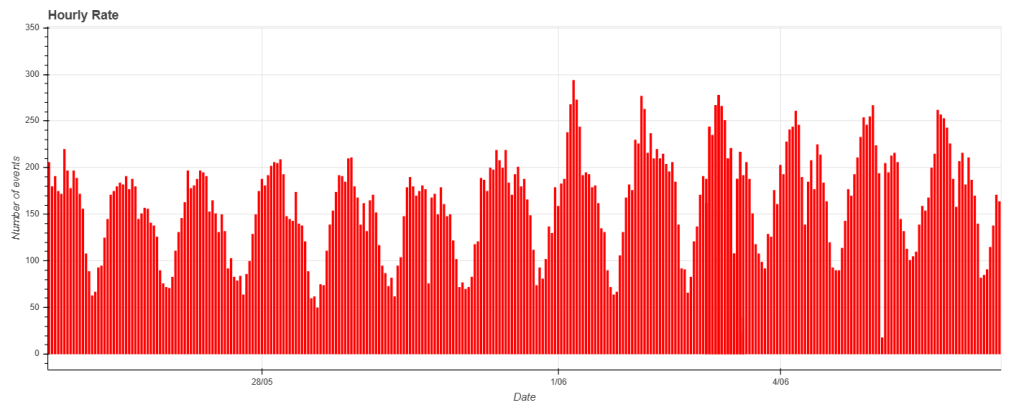
Fig. 3: Hourly rate between the end of May and the beginning of June 2025.
The CARMELO network
The network currently consists of 14 receivers, 13 of which are operational, located in Italy, the UK, Croatia and the USA. The European receivers are tuned to the Graves radar station frequency in France, which is 143.050 MHz. Participating in the network are:
- Lorenzo Barbieri, Budrio (BO) ITA
- Associazione Astrofili Bolognesi, Bologna ITA
- Associazione Astrofili Bolognesi, Medelana (BO) ITA
- Paolo Fontana, Castenaso (BO) ITA
- Paolo Fontana, Belluno (BL) ITA
- Associazione Astrofili Pisani, Orciatico (PI) ITA
- Gruppo Astrofili Persicetani, San Giovanni in Persiceto (BO) ITA
- Roberto Nesci, Foligno (PG) ITA
- MarSEC, Marana di Crespadoro (VI) ITA
- Gruppo Astrofili Vicentini, Arcugnano (VI) ITA
- Associazione Ravennate Astrofili Theyta, Ravenna (RA) ITA
- Akademsko Astronomsko Društvo, Rijeka CRO
- Mike German a Hayfield, Derbyshire UK
- Mike Otte, Pearl City, Illinois USA
The authors’ hope is that the network can expand both quantitatively and geographically, thus allowing the production of better quality data.
Expanding an observation network such as CARMELO (4), in fact, is crucial to improving the quality and quantity of data collected. First and foremost, increasing the number of receivers allows for greater continuity in recording events, reducing the risk of signal loss due to technical failures or local outages.
However, the real quantum leap is achieved with a wider geographic distribution. When receivers are located in different areas far apart, data can be compared and meteor trajectories can be reconstructed more accurately. An extended network also allows simultaneous events to be detected from multiple vantage points, strengthening the scientific validity of observations. Going forward, global coverage may prove essential for detecting rare transient phenomena, capturing unexpected meteor showers, and providing data to support other monitoring tools.
Finally, engaging new observatories in different regions also means strengthening international collaboration and expanding public participation in scientific research.
References
(1) A. Egal et al. (2020): Activity of the Eta-Aquariid and Orionid meteor showers, Astronomy & Astrophysics, Vol. 640
(2) Two meteor shower outbursts with potential connection to comet 73P, Central Bureau for Astronomical Telegrams, CBET 5561
(3) A Egal et al (2023): Modelling the 2022 τ-Herculid outburst, The Astrophysical Journal, Vol. 949
(4) L. Barbieri et al. (2024): What CARMELO can observe, eMeteorNews, vol. 9, no. 4, p. 241-248

